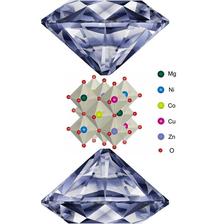Example of a high-entropy oxide between the anvils of a diamond anvil cell used to exert increasing pressure on the sample. (Credit: Center for High Pressure Science, Qiaoshi Zeng)
In a high-pressure X-ray study at PETRA III, scientists have gained new insights into the characteristics of a promising new class of materials for batteries and other applications. The team led by Qiaoshi Zeng from the Center for High Pressure Science in China used the brilliant X-rays from DESY's research light source to analyse a so-called high-entropy oxide (HEO) under increasing pressure. The study, published in the journal Materials Today Advances is a first, but very important step paving a way for a broader picture and solid understanding of HEO materials.
Modern society requires industry to manufacture efficiently sustainable products for everyday life, for example batteries for smart phones. About five years ago, a new class of materials emerged that appears to be very promising for the design of new applications, especially batteries. These high-entropy oxides consist of at least five metals that are distributed randomly in a common simple crystal lattice, while their crystal structure can be different from each metal's generic lattice. A popular example of a HEO material consists of 20 per cent each of cobalt, copper, magnesium, nickel and zinc for every oxygen atom, or (Co0.2Cu0.2Mg0.2Ni0.2Zn0.2)O.
“The materials group of high-entropy systems spanning from metallic alloys to ceramics systems can satisfy the demand for smart products in an almost infinite multi-dimensional composition space for various areas of our everyday life,” says Zeng. “In particular, high-entropy oxides offer exceptional properties, which can be employed in industrial applications including transportation and avionic technologies, but also in various forms in consumer electronics devices such as batteries for smart phones.” For instance, an implementation of HEO in a form of membrane material could make the future Li-ion batteries more robust. Understanding these new materials requires a multi-disciplinary scientific approach to reveal the secrets behind efficiency, sustainability, and the physics involved. “At the moment we lack a complete understanding and the bigger picture of the origin of the efficiency,” says Zeng.
Lattice distortion is believed to be inevitable and plays an important role in controlling the structure and superior properties of HEOs. The team studied the high-entropy oxide (Co0.2Cu0.2Mg0.2Ni0.2Zn0.2)O at the Extreme Conditions Beamline P02.2 of PETRA III. By taking advantage of the simple material structure, the team used high pressures of up to 40 Gigapascals (40 000 times the atmospheric pressure) as a powerful tool to successfully reveal and control distortions of the crystal structure on the atomic scale which is important for lithium-ion conductivity and dielectric properties of the material, for example. In general, high pressure tuning is considered as an important technique to prepare future chemical doping which can significantly improve the properties of materials.
The multi-disciplinary study involved X-ray diffraction, Raman spectroscopy, transmission electron microscopy and other techniques. “We could witness how the initial simple structure of this compound, resembling table salt at ambient conditions, becomes anisotropic and distorted above 9 to 10 Gigapascals“, reports Konstantin Glazyrin from DESY. “Above 10 Gigapascals, the significance of local nano-scale distortions increases, and further compression results in a peculiar phase transformation. The observed evidence indeed paves a way for a better understanding of HEO materials, but at the same time it also promotes high pressure as an efficient tool for their exploration and engineering.”
Also, the results for these nanocrystalline samples were substantially different from those of bulk HEO samples. This suggests that the properties of these materials change dramatically with size. As the team writes, pressure-induced structural tuning might be a general feature in HEOs and is worth a more extensive exploration, as it could not only promote a fundamental understanding of these new materials, but also guide applications.
(from DESY News)
Reference:
Lattice distortion and stability of (Co0.2Cu0.2Mg0.2Ni0.2Zn0.2)O high- entropy oxide under high pressure; B. Cheng, H. Lou, A. Sarkar, Z. Zeng, F. Zhang, X. Chen, L. Tan, K. Glazyrin, H.-P. Liermann, J. Yan, L. Wang, R. Djenadic, H. Hahn, Q. Zeng; Materials Today Advances, 2020; DOI: 10.1016/j.mtadv.2020.100102







